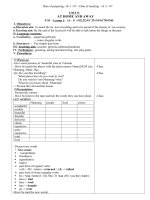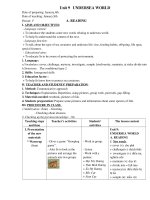Unit 9 an electrical substation
Bạn đang xem bản rút gọn của tài liệu. Xem và tải ngay bản đầy đủ của tài liệu tại đây (295.58 KB, 5 trang )
Unit 9: An electrical Substation
I. READING AND COMPREHENSION
What is an electrical substation
An electrical substation is a subsidiary station of an electricity generation,
transmission and distribution system where voltage is transformed from high to low or the
reverse using transformers.
Explanation
Transformation may take place in several stages in sequence, starting at the
generating plant where the voltage is increased for transmission purposes and is then
progressively reduced to the voltage required for household or industrial use. The range of
voltages in a power system varies from 110 V up to 765 kV depending on the country.
A substation that has a step-up transformer increases the voltage while decreasing
the current, while a step-down transformer decreases the voltage while increasing the
current for domestic and commercial distribution. The word substation comes from the
days before the distribution system became a grid. The first substations were connected to
only one power station where the generator was housed, and were subsidiaries of that
power station.
Substations generally contain one or more transformers, and have switching,
protection and control equipment. In a large substation, circuit breakers are used to
interrupt any short-circuits or overload currents that may occur on the network. Smaller
distribution stations may use recloser circuit breakers or fuses for protection of branch
circuits. Substations do not (usually) have generators, although a power plant may have a
substation nearby. A typical substation will contain line termination structures, highvoltage switchgear, one or more power transformers, low voltage switchgear, surge
protection, controls, and metering. Other devices such as power factor correction
capacitors and voltage regulators may also be located at a substation.
Substations may be on the surface in fenced enclosures, underground, or located in
special-purpose buildings. High-rise buildings may have indoor substations. Indoor
substations are usually found in urban areas to reduce the noise from the transformers, for
reasons of appearance, or to protect switchgear from extreme climate or pollution
conditions.
67
Where a substation has a fence, it must be properly grounded to protect people
from high voltages that may occur during a fault in the transmission system. Earth faults
at a substation can cause Earth Potential Rise at the fault location.
Transmission substation
A transmission substation is one whose main purpose is to connect together various
transmission lines. The simplest case is where all transmission lines have the same
voltage. In such cases, the substation contains high-voltage switches that allow lines to be
connected together or isolated for maintenance.
Transmission substations can range from simple to complex. The largest
transmission substations can cover a large area (several acres/hectares) with multiple
voltage levels, and a large amount of protection and control equipment (capacitors, relays,
switches, breakers, voltage and current transformers).
Distribution substation
Underground distribution system:
Upgraded predominantly by CAB or C.C.Box methods.
Underground distribution system:
C.C.Box method is positively adopted.
(C.C.Box method)〉
(CAB method〉
70cm
150cm
50
cm
150
cm
A distribution substation is one whose main purpose is to transfer power from the
transmission system to the distribution system of some area. It is uneconomical to directly
connect electricity consumers to the main transmission network (unless they use large
amounts of energy); so the distribution station reduces voltage to a value suitable for
connection to local loads.
The input for a distribution substation is typically at least two transmission or
subtransmission lines. Input voltage may be, for example, 115 kV, or whatever is
common in the area. The output is a number of feeders. Distribution voltages are typically
medium voltage, between 2.4 and 33 kV depending on the size of the area served and the
practices of the local utility.
68
The feeders will then run overhead, along streets (or under streets, in a city) and
eventually power the distribution transformers at or near the customer premises.
Besides transforming the voltage, the job of the distribution substation is to isolate
faults in either the transmission or distribution systems. Distribution substations may also
be the points of voltage regulation, although on long distribution circuits (several
km/miles), voltage regulation equipment may also be installed along the line.
Complicated distribution substations can be found in the downtown areas of large
cities, with high-voltage switching, and switching and backup systems on the low-voltage
side. More typical distribution substations have a switch, one transformer, and minimal
facilities on the low-voltage side.
Task 1. Checking facts and ideas
1. Transformation may happen in several stages in sequence, starting at the
generating plant where the voltage is increased for transmission purposes and is
then progressively reduced to the voltage required for household or industrial use.
2. The range of voltages in a power system range from 110 V up to 765 kV
depending on the country
3. A substation that has a step-up transformer increases the voltage while decreasing
the current, while a step-down transformer reduces the voltage while increasing
the current for domestic and commercial distribution.
4. The first substations were connected to only one power station where the generator
was located, and were subsidiaries of that power station.
5. In a large substation, circuit breakers are used to pause any short-circuits or
overload currents that may occur on the network.
6. Other devices such as power factor correction capacitors and voltage regulators
may also be placed at a substation.
7. Where a substation has a fence, it must be properly earthed to protect people from
high voltages that may occur during a fault in the transmission system
Task 2. Checking facts and ideas
1. Substations always increases the voltage while decreasing the current for domestic
and commercial distribution. (F)
2. The minimum level of voltage in a power system is 110 kV and the maximum one
is 765 kV depending on the country. (T)
3. Circuit breakers are used to interrupt any short-circuits or overload currents that
may occur on the network in every substation. (F)
69
4. Indoor substations are hardly built in rural areas, but urban ones to decrease the
noise from the transformers, for reasons of appearance, or to protect switchgear
from extreme climate or pollution conditions. (T)
5. Recloser circuit breakers or fuses for protection of branch circuits are dedicatedly
used for smaller scale distribution substations.
Transmission Substations
6. There is a wide range of transmission substations from simple to complicated one.
7. The big transmission substations can cover a large area (several acres/hectares)
with multiple voltage levels, and a large amount of protection and control
equipment (capacitors, relays, switches, breakers, voltage and current transformers.
Distribution Substations
8. It is not cost-effective to indirectly connect electricity consumers to the main
transmission network (unless they use large amounts of energy); so the distribution
station reduces voltage to a value suitable for connection to local loads (F)
9. The functions of the distribution substation is not only to isolate faults in either the
transmission or distribution systems but also to transform the voltage.(T)
10. Complex distribution substations are usually built in the urban areas, with highvoltage switching, and switching and backup systems on the low-voltage side. (T)
II. GUIDED WRITING
Sentence Building
1. If
The frequency of the power system rises about 0.5 [Hz] and more or falls about 1.5
[Hz] and more.
The frequency of the power system rises about 0.5 [Hz] and more or falls about 1.5
[Hz] and more
2. In order to
Secure stable power supply in the power system
New installation, extension, improvement, repair and inspection of power facilities
are indispensable, and stop of facilities become necessary in the process of these
construction works
3. So that
As a result of system supervision, control of power flow is carried out by switching
power system or by controlling power generation
The power system can be operated under the condition of standard value for safety
operation, if necessary
70
4. In order to
In the case of loop system, in addition to switching of power system and control of
power generation, series capacitor and phase shifting transformer may be used
Change the power flow distribution
5. So that
In the case of abnormal weather or thunderstorm, switching of power system and
control of power generation are carried out to control the power flow supplied for the
region
Influence may become as small as possible even when fault occurs
6. When
Transmission line is interrupted by a fault.
Recovery operation is performed aiming at power supply as early as possible on
the assumption that the fault has disappeared
7. When
Wide-area outage occurs.
Comprehensive recovery control of the whole system is needed
8. Since
Reactance of the circuit is larger than resistance in general.
Reactive power affects greatly voltage fluctuation rather than active power
9. Which
The system processes load dispatching work automatically
The system is called automatic load dispatching system
10. Since
Large-scale information transmission system and computers are needed.
The application of this system is limited to extra-high voltage system or above in
some power companies
71









